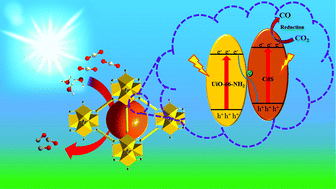Integration of zirconium-based metal–organic framework with CdS for enhanced photocatalytic conversion of CO2 to CO†
Abstract
It is a promising strategy to prepare composite photocatalysts based on MOFs and semiconductors for enhancing photocatalytic reduction of carbon dioxide (CO2). A family of binary composite photocatalysts (CdS@UiO-66-NH2) with different CdS contents have been designed and synthesized, which have been explored for photocatalytic reduction of CO2. CdS@UiO-66-NH2 can efficiently convert CO2 into CO under visible light irradiation via the solid–gas mode in the absence of sacrificial agents and photosensitizers. The generation rate of CO can reach up to 280.5 μmol g−1 h−1, which is 2.13-fold and 2.9-fold improvements over the pristine CdS and UiO-66-NH2, respectively, and the selectivity for CO is very high. Furthermore, this kind of photocatalysts can still maintain great photocatalytic activity in CO2/N2 mixed atmosphere with different CO2 concentrations. The outstanding performances of CdS@UiO-66-NH2 may be attributed to the existence of the direct Z-scheme heterojunction, which possesses the enhanced separation and migration of photo-generated charge carriers between UiO-66-NH2 and CdS, available specific surface areas and improved visible light absorption ability as well as abundant reaction active sites. This case reveals that MOF-based composite photocatalysts exhibit promising potential applications in the field of CO2 conversion.



 Please wait while we load your content...
Please wait while we load your content...